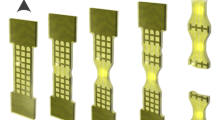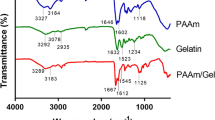Abstract
The application of hydrogels as substitutes for load-bearing tissues has garnered considerable attention. In contrast to load-bearing tissues, which can withstand complex loads with limited deformations, conventional hydrogels cannot exhibit a stiff response in the low-strain regime due to their soft natures. Herein, we reported the design of composite hydrogels inspired by the synergy between soft and hard constituents from load-bearing tissues. This design with a soft matrix (positive Poisson’s ratio) and hard skeletons (negative Poisson’s ratio) was up to 18.9 and 4.2 times stiffer than the matrix and skeleton, respectively. Instead, the combination of a soft matrix and skeletons with a positive Poisson’s ratio showed limited improvement. The underlying mechanism by the repulsion effect of positive and negative Poisson’s ratio between the soft matrix and hard skeletons was revealed using finite element analysis. This study offers insight into the future design of composite hydrogels based on the synergistic effect of soft and hard components.
摘要
水凝胶作为承载组织的替代产品引起了广泛关注. 然而, 与能够 通过有限的变形来承受复杂载荷的承载组织不同, 传统的水凝胶由于 其柔软的特性, 无法在低应变状态下表现出刚性响应. 基于承载组织的 软硬组分之间的协同作用, 我们设计了采用软基质(正泊松比)和硬框架 (负泊松比)的复合水凝胶, 其刚度分别比基质和框架高18.9和4.2倍. 相 反, 结合软基质(正泊松比)和框架(正泊松比)的设计对刚度增强有限. 通过有限元分析, 揭示了软基质与框架之间正、负泊松比斥力作用的 内在机理. 本研究为今后设计基于软硬组分协同效应的复合水凝胶提 供了思路.

Similar content being viewed by others
References
Becker ML, Burdick JA. Introduction: Polymeric biomaterials. Chem Rev, 2021, 121: 10789–10791
Harrington MJ, Fratzl P. Natural load-bearing protein materials. Prog Mater Sci, 2021, 120: 100767
No YJ, Castilho M, Ramaswamy Y, et al. Role of biomaterials and controlled architecture on tendon/ligament repair and regeneration. Adv Mater, 2020, 32: 1904511
Yang F, Zhao J, Koshut WJ, et al. A synthetic hydrogel composite with the mechanical behavior and durability of cartilage. Adv Funct Mater, 2020, 30: 2003451
Visser J, Melchels FPW, Jeon JE, et al. Reinforcement of hydrogels using three-dimensionally printed microfibres. Nat Commun, 2015, 6: 6933
Xu L, Zhao X, Xu C, et al. Water-rich biomimetic composites with abiotic self-organizing nanofiber network. Adv Mater, 2018, 30: 1703343
Xu X, Jerca VV, Hoogenboom R. Bioinspired double network hydrogels: From covalent double network hydrogels via hybrid double network hydrogels to physical double network hydrogels. Mater Horiz, 2021, 8: 1173–1188
Gong JP, Katsuyama Y, Kurokawa T, et al. Double-network hydrogels with extremely high mechanical strength. Adv Mater, 2003, 15: 1155–1158
Chen Y, Ma Y, Yin Q, et al. Advances in mechanics of hierarchical composite materials. Compos Sci Tech, 2021, 214: 108970
Liu B, Feng X, Zhang SM. The effective Young’s modulus of composites beyond the Voigt estimation due to the Poisson effect. Compos Sci Tech, 2009, 69: 2198–2204
Vogel S. Comparative Biomechanics: Life’s Physical World. Princeton: Princeton University, 2003
Hwa HJ. Could the intraosseous fluid in cancellous bone bear external load significantly within the elastic range?. Proc Inst Mech Eng H, 2004, 218: 375–379
Afghah F, Iyison NB, Nadernezhad A, et al. 3D fiber reinforced hydrogel scaffolds by melt electrowriting and gel casting as a hybrid design for wound healing. Adv Healthcare Mater, 2022, 11: 2102068
Papadopoulou A, Laucks J, Tibbits S. Auxetic materials in design and architecture. Nat Rev Mater, 2017, 2: 17078
Huang C, Chen L. Negative Poisson’s ratio in modern functional materials. Adv Mater, 2016, 28: 8079–8096
Liu B, Zhang L, Gao H. Poisson ratio can play a crucial role in mechanical properties of biocomposites. Mech Mater, 2006, 38: 1128–1142
Zhang XG, Ren X, Jiang W, et al. A novel auxetic chiral lattice composite: Experimental and numerical study. Composite Struct, 2022, 282: 115043
Li T, Chen Y, Hu X, et al. Exploiting negative Poisson’s ratio to design 3D-printed composites with enhanced mechanical properties. Mater Des, 2018, 142: 247–258
Luo HC, Ren X, Zhang Y, et al. Mechanical properties of foam-filled hexagonal and re-entrant honeycombs under uniaxial compression. Composite Struct, 2022, 280: 114922
Okumura T, Takahashi R, Hagita K, et al. Improving the strength and toughness of macroscale double networks by exploiting Poisson’s ratio mismatch. Sci Rep, 2021, 11: 13280
Guo J, Zhang H, Zhang H, et al. Jellyfish tentacle-inspired hydrogel microfibers implanted with discrete structural color microsphere tactile sensing units. Adv Fiber Mater, 2022, 4: 1209–1218
Khan AQ, Yu K, Li J, et al. Spider silk supercontraction-inspired cotton-hydrogel self-adapting textiles. Adv Fiber Mater, 2022, 4: 1572–1583
He W, Di Y, Jiang N, et al. Graphene-oxide seeds nucleate strong and tough hydrogel-based artificial spider silk. Acta Phys Chim Sin, 2022, 38: 2204059
Huang X, Ge G, She M, et al. Self-healing hydrogel with multiple dynamic interactions for multifunctional epidermal sensor. Appl Surf Sci, 2022, 598: 153803
Zhang S, Zhou H, Huang C, et al. A novel corneal adhesive based on functionally coupled PEG-lysozyme hydrogel for wound closure after surgical eye surgery. Chin Chem Lett, 2022, 33: 4321–4325
Bai P, Ma M, Sui L, et al. Nanoconfinement controls mechanical properties of elastomeric thin films. J Phys Chem Lett, 2021, 12: 8072–8079
Treloar, LRG. The Physics of Rubber Elasticity. Oxford: Clarendon Press, 1975
Chen W, Watts S, Jackson JA, et al. Stiff isotropic lattices beyond the Maxwell criterion. Sci Adv, 2019, 5: eaaw1937
Ashby MF. The properties of foams and lattices. Phil Trans R Soc A, 2006, 364: 15–30
Deshpande VS, Ashby MF, Fleck NA. Foam topology: Bending versus stretching dominated architectures. Acta Mater, 2001, 49: 1035–1040
Gibson LJ, Ashby MF (eds.). Cellular Solids: Structure and Properties. New York: Cambridge University Press, 1997
Schaedler TA, Jacobsen AJ, Torrents A, et al. Ultralight metallic microlattices. Science, 2011, 334: 962–965
Yu X, Zhou J, Liang H, et al. Mechanical metamaterials associated with stiffness, rigidity and compressibility: A brief review. Prog Mater Sci, 2018, 94: 114–173
Chen Z, Wu X, Xie YM, et al. Re-entrant auxetic lattices with enhanced stiffness: A numerical study. Int J Mech Sci, 2020, 178: 105619
Peng XL, Soyarslan C, Bargmann S. Phase contrast mediated switch of auxetic mechanism in composites of infilled re-entrant honeycomb microstructures. Extreme Mech Lett, 2020, 35: 100641
Wagner MA, Lumpe TS, Chen T, et al. Programmable, active lattice structures: Unifying stretch-dominated and bending-dominated topologies. Extreme Mech Lett, 2019, 29: 100461
Acknowledgements
This work was financially supported by the National Natural Science Funds for Distinguished Young Scholars (21725401), the National Key R&D Program of China (2017YFA0207800), and the National Natural Science Foundation of China (22161142021).
Author information
Authors and Affiliations
Contributions
Shi W, Yan H and Liu M designed the project. Shi W performed the experiments. Shi W, Yan H, Xu Y and Huang J analyzed the results. Shi W, Yan H and Liu M wrote the paper. All authors contributed to the general discussion of the article.
Corresponding authors
Additional information
Conflict of interest
The authors declare that they have no conflict of interest.
Supplementary information
Supporting data are available in the online version of the paper.
Wei Shi is a doctoral student at Beihang University. In 2017, he earned a Bachelor of Science in polymer materials and engineering from Sichuan University. Then, he joined the group of Professor Mingjie Liu at Beihang University. His current research interests center on high-performance polymer composites and their applications.
Yichao Xu is currently an Advanced Innovative Fellow at Beihang University. In 2010 and 2016, she earned her Master and PhD degrees in mechanical engineering from the University of California, San Diego. Her research focuses on the wave propagation in nonlinear granular and heterogeneous materials, the mechanics of auxetic metamaterials, and the design of bio-inspired functional metamaterials.
Hao Yan currently serves as an associate professor at Beihang University. He received his PhD degree in 2011 from the National Center for Nanoscience and Technology, Chinese Academy of Sciences, and then joined Professor Zhong Zhang’s research team in 2006. From 2011 to 2018, he worked at the Sinopec Beijing Research Institute of Chemical Industry. His current research interests center on the design of bioinspired surfaces and hydrogels.
Mingjie Liu is a full-time professor at Beihang University. In 2005, he joined Prof. Lei Jiang’s group and received his PhD degree from the National Center for Nanoscience and Technology, Chinese Academy of Sciences (2010). From 2010 to 2015, he worked as a postdoc in Prof. Takuzo Aida’s group at Riken in Japan. He received the “1000 Youth Plan” grant and enrolled at Beihang University in 2015 and the National Natural Science Funds for Outstanding Young Scholars in 2017. His current research focuses on the bioinspired design and application of polymer materials.
Electronic Supplementary Material
40843_2022_2336_MOESM1_ESM.pdf
A composite hydrogel exhibiting stiff response at low-strain regime by repulsion effect of positive/negative Poisson’s ratio
Rights and permissions
About this article
Cite this article
Shi, W., Huang, J., Zhou, T. et al. A composite hydrogel exhibiting stiff response at low-strain regime by repulsion effect of positive/negative Poisson’s ratio. Sci. China Mater. 66, 1941–1948 (2023). https://doi.org/10.1007/s40843-022-2336-y
Received:
Accepted:
Published:
Issue Date:
DOI: https://doi.org/10.1007/s40843-022-2336-y




